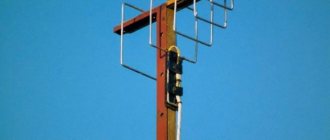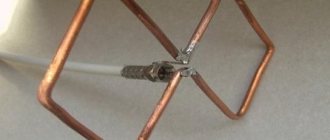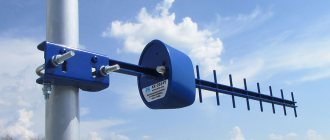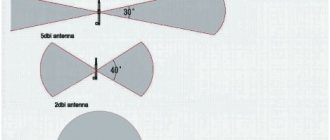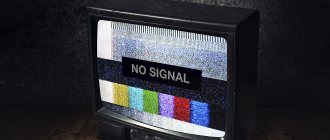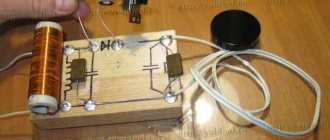A television antenna, which is made by yourself and is designed to receive a digital signal (DVB-T2), may not be inferior in quality to factory receiving devices. Depending on the task, terrain, operating conditions, a homemade antenna can be made in different ways. The design can be either very simple or performed after calculating a bunch of formulas. If you make accurate calculations, then you can successfully catch two multiplexes on your TV (each with 10 channels, a total of 20 channels will be received on TV).
Types of receiving antennas
A set of channels is provided to users through broadcasting on specific frequency bands. There is analogue television and digital. Each broadcast occurs on different bands, the antenna must be appropriate.
- For terrestrial analogue TV, a meter antenna (MF) is required. The signal is transmitted and received in the range of 1-300 MHz.
- Digital broadcasting is performed on shorter waves, which correspond to the range of 0.3-3 GHz. A decimeter antenna (UHF) is required, which will pick up shorter waves than when transmitting an analog signal.
- If you need to receive meter and decimeter waves at once, then you need broadband devices. The design contains vibrators of different sizes to operate at different frequencies.
Depending on the location, there are external and internal. The first ones are installed outdoors, on the roofs of houses and other places. They can be used in an apartment building for all residents at once or for one in the case of an individual connection. Internal ones are installed at home. They may not even have a cable, but are attached directly to the TV.
There are also:
- active antennas, on which the signal is amplified by a connected amplifier (power is received from an external unit inside the apartment or from a television signal receiver - a TV or set-top box);
- passive - they themselves amplify the receiving signal due to their design (observance of the size of the antenna and the shape of the conductors is required).
What are you connecting the antenna to?
To digital set-top box
51.2%
To TV
48.8%
Voted: 709
Prices and companies
In any case, a specialist will be able to install the antenna faster and better than an amateur.
Also, many antenna owners do not want to “play” with its installation, and therefore we suggest considering how much it costs to set up and install a satellite dish in different cities of Russia and Ukraine. Price table, cost of installing an azimuth satellite dish 43 cm, 0.55-0.6:
| City | Price, rubles |
| Almaty | 2400 |
| Barnaul | 2500 |
| Vladivostok | 2500 |
| Volgograd | 2400 |
| Donetsk | 2500 |
| Rostov-on-Don | 2400 |
| Ekaterinburg | 2400 |
| Zaporozhye | 2500 |
| Irkutsk | 2400 |
| Karaganda | 2300 |
| Kyiv | 2500 |
| Minsk | 2500 |
| Moscow | 2500 |
| Odessa | 2400 |
| Permian | 2400 |
| Samara | 2300 |
| Saint Petersburg | 2500 |
| Saratov | 2400 |
| Kharkiv | 2400 |
| Ulan Ude | 2400 |
| Novosibirsk | 2500 |
Independent and professional setup of the satellite antenna Yamal (Yamal 201 90E), Tricolor TV Siberia (Tricolor), HotBird (HotBird), GAL, Orion, Samsung DSB-S300V is carried out within several hours, under normal weather conditions. The most popular models now are: SatelliteAntennaAlignment (Germany), ABS-1, LMI 75, ExpressAM2 80, Turksat 1C/2A 42E, Satgate, StrongSRT90 Multisat, HDHumaxVAHD-3100S, PBIDVR-1000S, OpenboxSF-20.
Antenna options for digital signal reception
Reception of DWM waves can be carried out by many antennas. To display DVB-T2 digital television, the receiver can be constructed from only one cable, or from additional elements.
Each television receiver will have different characteristics. They must be taken into account when choosing, especially if you live far from the city where there are no TV towers nearby.
Below is a table of the most common TV antennas. They work best and are the easiest to manufacture.
| Type | Coef. gain, dB | Maximum signal reception range, km | Operating range, MHz | |
| Without amplifier | With gain | |||
| From cable | 0-3 | 15 | 15 | 440-800 |
| From cans | 3-5 | 15 | 40 | 470-622 |
| Butterfly | 5-11 | 20 | 70 | Any (needs calculations) |
| Triple square | 9 | 15 | 60 | |
| Kharchenko (or biquadrat) | 5-6 | 10 | 50 | |
| Log-periodic | 8-12 | 30 | 100 | |
There are more complex options. But despite all the difficulties in manufacturing, they have significant drawbacks. At the same time, the quality of reception is not so high compared to the table ones. Therefore, there is no point in doing them yourself. For example:
- Kovachev antenna;
- Turkina;
- wave channel.
Satellite dish made of thin metal sheet
To make this option, we will need a sheet of thin galvanized metal with a thickness of 1...1.5 mm and dimensions of approximately 100 × 100 mm. You can use it to make a plate with a diameter of about 80 mm. To correctly mark and cut the metal, first take cardboard of a suitable size and draw it into 16 identical circular sectors (each sector is shifted relative to the previous one by approximately 22.5). Then we draw 4 circles with radii of 75, 254, 400 and 538 mm, respectively. The last circle will go beyond the cardboard square, so we simply cut off those pieces that will be on the outside. We will then bend the template along these circles. At the next stage of making the template, we make cuts along all 16 beams, maintaining the distance C1...C4. Dimensions C1=0 mm, C2=11 mm, C3=29 mm and C4=50 mm.
After the cutouts on the template are ready, they are transferred to a sheet of metal using a metal ruler and a sharply sharpened scriber. Using metal scissors, carefully cut out the blank (cutting) of the future plate. At the last stage, the metal petals are connected to each other and a finished antenna mirror is obtained.
How to make an antenna
In addition to the description of the manufacturing process, the advantages and disadvantages of each antenna for digital TV will be described. Not every type of antenna can be quickly made for a TV. This is explained by the complexity of the design and the need for appropriate calculations.
Antenna cable loop
This can always be done if the old antenna has stopped showing.
DIY satellite television. Part 1.
Despite the title, the article below will not talk about how to make a satellite dish or solder a receiver yourself. Just a note about what you need to purchase and how to install and configure everything yourself in order to watch TV channels on your plate.
Suppose you live in a country house, in a village, or simply “far from civilization.” But I want to watch TV, and not a couple of channels broadcast on the air.
(A small digression: digital terrestrial broadcasting is actively developing at the moment. Find out if the number of channels you need is available in your area via terrestrial digital television? In this case, you will only need a set-top box for receiving a digital signal (if the TV does not support it), and you can use an antenna do not change.)
And so you decided to acquire satellite equipment to watch many TV shows. First you need to decide: what channels do you want to watch? If your goal is various Discovery, Viasat and/or purely sports channels, then we immediately inform you: it is better to conclude an agreement with one of the companies providing satellite television services for a subscription fee. Such channels are transmitted in encrypted form and only some of them can be viewed “on the ball”. Fortunately, nowadays there are enough companies involved in installing satellite equipment and providing paid services. You can order installation even in the middle of nowhere, the only question is the cost.
If you decide to go this route, we will give you some advice here: 1) if there are several offers, carefully study the list of channels provided in a particular package, the need to pay extra separately for sports, educational channels, etc.; 2) the possibility of free installation of equipment by company specialists; 3) is there a separate charge for “kilometers to the client” upon departure? 4) it’s a good idea to pay attention to the company’s reputation: read it on the Internet, ask clients; 5) find out whether the signal quality of the equipment installed by the company is good in your area; 6) it is often possible to connect profitably (for example, equipment or installation at cheap prices, half the monthly fee for some time for a more expensive package, or even a couple of months of “freebies”) for various types of promotions; As a rule, to attract customers, large companies hold them regularly: on New Year’s, on company anniversaries, etc.; 7) well, and advice that is suitable for any transaction: carefully read the signed agreement BEFORE signing, and not after, coming home and relaxing in front of your favorite TV channel; It may well be that a promotion that is profitable at first glance obliges you to use the services for at least a couple of years after concluding the contract, otherwise a penalty will be written off, etc.; in general: always be on your guard! and enjoy watching!
For those who decided to do everything themselves , the material is below.
Again, to begin with, let’s make a reservation: this information is most suitable for those who live in the European part of the former USSR. So what is needed? To begin with: desire! The desire to do everything yourself (or with someone’s help). Without this, you may not reach a successful ending. Then patience, a steady hand, a minimum of tools and some cash. Regarding the last one. A lot depends on where, what and from whom you will purchase. But even if you buy everything new, you can easily invest in the equivalent of 100 UDS, unless, of course, you are chasing branded equipment. And it doesn’t always make sense to purchase everything new, for example, if there is a profitable used offer on the market. The same dish or receiver is not a flash drive: it can work for a very long time and with high quality (although there are also reliable flash drives
And again, a small digression: an introduction to the world of satellite television . What is this anyway? First, let's take a look at Wikipedia.
Geostationary orbit (GSO) is a circular orbit located above the Earth’s equator (0° latitude), while in which an artificial satellite orbits the planet with an angular velocity equal to the angular velocity of the Earth’s rotation around its axis. In a horizontal coordinate system, the direction to the satellite does not change either in azimuth or height above the horizon; the satellite “hangs” motionless in the sky.
Those. somewhere high in space, at an altitude of approximately 36 km from the surface of the Earth, an artificial satellite of the Earth rotates synchronously with it, which is a powerful receiver and transmitter of a television signal. It receives the signal from high-power ground transmitting antenna(s) and transmits it to a large area below it. In fact, there are many satellites. Each of them broadcasts to a specific area according to the direction of its transmitting antennas. Several conclusions follow from this: the satellite is very far away, it is limited in mass, volume, power supply capabilities, it is impossible to repair it if something happens, hence the complexity, duplication of systems, etc. From all this the conclusion is: the power of the transmitting signal is limited, the signal from the satellite is very weak. Then, a satellite is expensive, which means it needs to be used to the maximum: transmit through it as many channels as possible to a large area of the Earth. The second conclusion: the usual technologies that we still use for transmitting on-air television and radio broadcasts are not suitable - the number of transmitted channels is too small. Therefore, satellite television uses modern digital data transmission methods. The third conclusion: all channels cannot be “stuffed” into one satellite for technical and organizational reasons.
Now let's see: what do these conclusions mean for us? Weak signal reception technology is required. A parabolic antenna is used for this. Here, the larger the area of the parabolic mirror, the better. Better for a signal that is collected and focused to a point. But the larger the antenna, the more expensive and heavier it is. It is more difficult to install, and securing it securely to counteract strong vert is generally a problem at home, as a rule. Therefore, in practice, they choose a size sufficient for high-quality reception, and for most of Eastern Europe this is a diameter of 0.8 meters. One of the most common diameters is 0.95 m. There are two main types of satellite antennas: direct focus and offset. The first ones have a signal receiver (irradiator) installed at the focus of the parabolic mirror, which coincides with the geometric one. In the second, the signal collected at a point from a parabolic mirror is reflected to a point below the geometric center of the antenna. This eliminates the shading of the useful area of the antenna by the feed and its supports, which increases its efficiency with the same mirror area as the direct-focus antenna. In addition, the feed is installed below the center of gravity of the antenna, thereby increasing its stability under wind loads. The offset antenna mirror is mounted almost vertically. Depending on the geographic latitude, the angle of its inclination varies slightly. This position prevents precipitation from collecting in the antenna bowl, which greatly affects the quality of reception. When viewed through the light, the antenna does not appear as a circle, but as an ellipse, elongated vertically. The dimensions of an offset antenna are usually given in terms of gain equivalent to the direct focus ones. If this size is the same horizontally, then vertically it will be approximately 10% larger. In the future, by satellite antenna we will only mean offset antenna, as it is the most common one.
Direct focus antenna.
Offset antenna.
There is also a distinction between fixed and mobile antenna mounting. In the first case, the antenna is fixedly attached to the base, in the second - to a special positioner. The latter’s task is to rotate the antenna in an arc to position it on the desired satellite. The signal to turn is usually given by a satellite receiver. It takes some time to accurately position the satellite when selecting a program from a different satellite than the current one. Technically implemented using a motor-actuator. Expensive and, therefore, not a common solution. The practical part will not be considered.
As mentioned above, the signal from the antenna is focused to one point, where a device called a converter (LNB head or low-noise block converter or low-noise monoblock converter) is installed. Based on the name “satellite converter,” it immediately becomes clear that this device converts (converts) something. An electromagnetic signal comes from the satellite, which is focused by the satellite dish onto the converter and converted by the LNB head into an intermediate frequency. This is necessary so that the signal can be efficiently transmitted further along the cable. In addition, the LNB head amplifies the received signal. Next, the signal via a coaxial cable from the LNB head goes to the satellite receiver, which, as a rule, is a separate device (the so-called satellite set-top box), but can also be built into the TV. Due to the fact that the satellite is very far away relative to the receiving antenna, you have to point this same antenna very precisely at the satellite itself. Let's summarize: to receive satellite television, you must, in addition to the TV itself, have the following equipment. 1) Parabolic antenna with a diameter of 0.8 m. 2) LNB head. 3) If you want to watch TV programs from more than one satellite, then you need a switch (switch) of DiSEqC heads. 4) Coaxial cable. 5) Satellite receiver.
This is where the theoretical part ends. Let's move on to the practical.
First, determine where to mount the parabolic antenna. The height above the ground does not play a special role. It is important that there are no obstacles on the satellite-antenna line. Even tree crowns. For residents of Eastern Europe, the direction to the satellite will be south with a shift to the west or east, depending on the coordinates of the antenna and satellite. After all, we remember that geostationary satellites are launched into equatorial orbit. The mounting location must be strong and securely fastened: even the slightest vibrations of the antenna will lead to signal loss. The best option is the main wall of the building or reinforced concrete roof slab. But other options are also suitable, for example, a rigidly reinforced vertically installed iron pipe of such a diameter that it does not sway during gusts of wind. Depending on the chosen mounting option, select the appropriate fastener, which is fixed on one side to a fixed surface, and the antenna itself is attached to the other. As a rule, the antennas themselves are not equipped with such a part. It can also be a home-made product, the main thing to remember is that the antenna has a large windage and it will need to be accurately aimed at the satellite, i.e. Reliability and ease of installation and configuration of the antenna itself are important. Then choose the antenna itself. Here it is better to ask the owners of satellite equipment in your area what diameter of the “dish” they use and whether the reception is good during thick clouds and/or rain. If, for example, it turns out that when receiving with an antenna with a diameter of 0.8 m, there is a loss of signal during heavy rain, then you should think about purchasing an antenna with a diameter of 0.95 m. At the same time, overpay for a 1.5 m “dish” diameter makes no sense. In addition, it may turn out that the one who provided you with the above information simply does not have the antenna pointed at the satellite accurately enough. In general, the advice of knowledgeable people and the experience of neighbors with “plates” will help here. Afterwards, you need to decide how many satellites you want to watch TV programs from? In theory, you can “overgrow” antennas like mushrooms after rain, but in practice the most common option is one “dish”, a mount for three receiving heads, three LNB heads, a DiSEqC switch for 4 heads, then a cable from DiSEqC to the receiver, the receiver itself, and from it to the TV. This is the so-called multi-feed scheme. Let's look again at Wikipedia. Multifeed is a set of devices (in particular, converters) designed to receive signals from several satellites onto one parabolic antenna. A multifeed is often called a bracket on which additional converters are mounted.
This scheme has been worked out for years; it allows you to watch a maximum of Slavic-language programs with minimal financial investment. With three LNB heads manually, without resorting to special equipment, it is possible to configure acceptable signal quality for the three most popular satellites in Eastern Europe: Amos 4W, Astra 4.9E, Hot Bird 13E. The beauty here is that you can use one antenna for these satellites. First, the antenna with the central head is configured, usually on the Hot Bird 13E, although it can be used on any other one. In this case, both the position of the plate itself and the head change to achieve the maximum signal level. The signal from this satellite with high-quality tuning will be the strongest. Then the other two are adjusted, but only through the heads themselves. The most common type of LNB head is for one output, as it is the most popular and cheapest. From it the signal goes via cable to the DiSEqC switch or receiver. With this scheme, it is possible to serve only one TV with a signal. But there are heads with a larger number of pins, which allows one antenna and LNB head to supply more than one receiver with a signal, thereby saving on equipment. This is very convenient if, for example, there is more than one TV in the house.
LNB heads: with one output and four.
In the second case, all 4 outputs can be connected to different receivers or DiSEqC. The receiver can simultaneously work with only one LNB head, this is where the DiSEqC switch is needed if you want to watch several satellites on one “dish”. Depending on the program selected by the user, he connects one or another LNB head to the receiver and supplies it with the supply voltage necessary for the head to operate. In the vast majority of cases, there is only one DiSEqC between the LNB head and the receiver, but there are intricate schemes with cascaded DiSEqC, but these are such rarely used cases that we will not consider them.
Next, you need a coaxial cable to connect DiSEqC and the receiver. It must be taken with a margin of a couple of meters relative to the distance that you are measuring. But remember that the longer the cable, the greater the loss.
It's time to talk about the receiver. This is a very broad topic. For most TV channel fans, a simple receiver, such as the Orton 4100C, will do. But general information on choosing a satellite set-top box will not harm anyone.
First of all, if you have a modern TV, then look at its instructions or read it on the Internet - it may happen that this TV already has the necessary digital signal receiver built into it.
Read the continuation here.
We use beer cans
A do-it-yourself dacha antenna made from beer cans is the simplest and most affordable passive type design. It can be done quickly and without basic skills. At the same time, it copes well with receiving UHF broadcasts.
To assemble an antenna from beer cans you will need:
- cable of sufficient length;
- aluminum cans (for the simplest design, 2 are enough);
- 2 bolts or self-tapping screws;
- plug (F - connector) for connecting the cable to the TV;
- electrical tape or tape;
- a base made of wood or plastic for attaching cans (you can use wooden coat hangers).
The antenna circuit is simple:
- Each can is attached with electrical tape or tape to the base pin at a distance of 7 cm from each other.
- The cable is stripped on one side. They are spread out and attached to the rings of the cans or to screwed-in screws. It can also be soldered. A plug is attached to the free end.
This simplest design is suitable for installation both indoors and outdoors. When used externally, the jars are covered with a large plastic container with the neck and bottom cut off. The cable is pulled through a hole made on the side, which can be sealed using boiling water. The finished receiver is connected and configured through automatic channel search.
You can also make an analogue of a satellite dish with your own hands. For this purpose, use a simple umbrella. You will also need:
- aluminium foil;
- copper cable;
- 1 tin can;
- amplifier and power supply for it.
Operating procedure:
- Measure the umbrella segments between the spokes and cut out elements corresponding to these dimensions from foil. They are sewn to the dome of the umbrella, covering its entire interior.
- A TV signal receiver is installed at the focal point of the metal grille. The amplifier will be a core from which 4 cm of braiding has previously been removed, and a cable screen that protects against interference.
- An oval is cut out of an aluminum can. A hole is made in the center of it, through which a bare wire is passed and a contact is soldered. To protect against oxidation and corrosion, the joint is covered with plasticine.
- The amplifier is powered through a cable.
- The receiver is attached to the handle of the umbrella with tape so that it does not touch the metal. This will protect against interference and distortion. The junction must be sealed with plasticine.
- The power supply is placed next to the TV, and the antenna is turned towards the repeater.
- Channels are established by driving the dish until the best signal is obtained.
Butterfly
In its design it resembles Polish analogues, which were widely used for receiving analogue broadcasts.
The antennae are located on the vertical frame. It is installed outdoors, for this reason it is necessary to use wire of sufficient thickness for the antennae so that the wind does not bend them. When using copper, 2-3 mm is enough; for aluminum, the thickness should be slightly larger.
The length of the antennae is calculated depending on the broadcast frequency of the repeater. For Moscow, broadcasting is carried out at a frequency of 314 MHz. We calculate the wavelength: 300/477 = 0.633 m. This is respectively 64 cm. The length of the active part is 16 cm.
After twenty centimeters we mark four points. We draw perpendiculars relative to the frame. Using a protractor, lines measure up and down an angle of 30 degrees in both directions.
When using a wooden frame, it is enough to use self-tapping screws to attach the antennae. After installing the antennae, we connect them with wire and attach the television cable.
